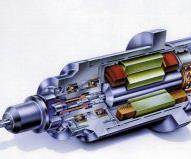Use Magnetic Chucks to Reduce Your Cost of Operation
By evaluating magnetic devices as a workholding alternative for moldmakers, cost and leadtime can be reduced.
|
Any plan for meeting the demands of today's customers has to include getting the pieces on and off machines as quickly as possible while ensuring adequate safety, allowing a cutting tool access to areas of the work that need to be machined, and achieving consistent holding pressure on the workpieces. This is especially applicable to pressure-sensitive workpieces that are prone to warp from the pressures of mechanical vises and clamps. Moldmakers must constantly evaluate the best approach to workholding. As users of CNC machining centers and milling machines, they are typically relying on the use of traditional clamping and fixturing methods, which require a significant setup time before an actual machining operation can begin. When a machining or milling operation involves the production of multiple parts or parts of varying dimensions, the amount of setup time increases exponentially, based on number, size and required orientation of parts, and contributes to an overall reduction in the operation's total productivity. The use of magnetic devices is a highly versatile workholding alternative for users to reduce setup time and increase productivity. Magnetic AlternativesMagnetic chucks are the most flexible type of workholding system for the widest range of machine tools, including horizontal and vertical machine tools, HSM centers, CNC lathes, mills, EDM palletized robotic applications and surface grinders. They are most flexible because of usage versatility. Using magnetic chucks to affix workpieces to the machining table or surface saves time over mechanical fastening or clamping. Workpieces are manually attached to the bed, using holding clamps or vises that must be screwed down or secured as part of the machine setup to ensure firm and accurate positioning of the workpiece according to the machine's CNC program. Magnetic chucks are more flexible or accommodating if a moldmaker wants to machine multiple parts with one setup or several parts of varying dimensions. Each of these scenarios would require much more setup time to prepare for the machining process versus use of magnetic workholding. They are more flexible, meaning capable, compared to vacuum workholding, because the holding power of the magnet can exceed the suction force created by the vacuum, which is particularly beneficial for machining large-size parts. Furthermore, setting up with vacuum chucks requires a mask to seal any holes that are not directly covered by the mounted workpiece. Having full support—the uniformed holding of the entire surface of the workpiece—reduces machining-induced vibration. The magnets have a damping effect on the work due to the fact that they are holding the work over a relatively large contact area compared to mechanical vises and clamps. Due to the solid-piece construction of the magnet, it acts as a buffer between the machine bed and workpiece to damp or impede vibration generated by the machine tool, which can affect the outcome of the workpiece. Using magnetic chucks allows the end user to run faster feeds and speeds without chatter. If a workpiece is held unevenly, or held to the machining bed with mechanical clamps or vises, the machine must be operated to accommodate those conditions, typically requiring multiple stops and starts. This stop/start action can create imperfections in the part surface, which must be corrected in a post-machining operation such as bench cleaning or polishing to remove any imperfections. Additionally, multiple CNC programs may be needed to work around mechanical clamps to achieve a desired surface or part configuration. Finally, faster feed rates are possible due to the magnet's ability to firmly hold the workpiece in place and precisely positioned while the grinding wheel, milling cutter or drill performs the material removal process. No longer associated only with surface grinding operations, magnetic workholding is gaining in popularity. More machine tool builders and end users are looking for ways to improve productivity or reduce setup time to improve their machines' processes and to create a more efficient machine with better ROI. Advances in technologies and materials make magnets viable holders for all types of machining of ferrous parts. For example, materials such as neodymium magnet (rare earth materials) give magnets the capability to achieve more aggressive holding forces for the parts while keeping the size and weight of the magnet at a manageable size. Selecting a Magnetic ChuckConsider these factors when selecting the type of magnetic chuck for an application (see Workholding Magnet Facts sidebar). Imposed Limit The most obvious limit to using magnetic workholding is that some materials, such as ceramics and plastics, as well as some metals such as stainless steel, aluminum or bronze, cannot be held by a magnet. However, if a workpiece is ferromagnetic—a material that contains iron particles in its metallurgical composition that react when exposed to or come in contact with a magnetic force—then magnetic chucks should be considered. Materials The machines and type of machining are important considerations for the basic selection. To determine the best magnetic solution, it is important to know the elements that will be applied to the workpiece by the type of machine to be used. Factors such as the horsepower, spindle speed, and size of cutter or tool are all part of the evaluation process, but other considerations include type of material, hardness, shape and flatness of the workpiece material. The variations of workpiece materials within a job and the differences from job to job require the application engineer or machinist—whomever has the responsibility for the part or component to be produced by the machining process—to select the style of magnetic chuck that will allow the most flexibility, matching the most appropriate magnetic chuck to a user's operation to get the desired result. Workpiece material, size, surface conditions and metal removal rates all have an impact on breakaway forces and must be taken into consideration, along with necessary holding power, accuracy, repeatability and durability requirements to ensure the best chuck is used for the job. Steels Mild steels are the most magnetically attractive because low carbon content not only has a bearing on material hardness, but also is a determining factor as to how magnetic the material is. Low carbon steels, such as SAE 1020 steel, are nearly as good conductors of magnetic lines of force as pure iron. Hard alloy steels are less attractive because many alloys contain non-magnetic materials, which reduce the ability of magnetic lines of force to flow into the workpiece. An alloy such as SAE 300 series of stainless steel is almost as poor a magnetic conductor as air. Type 416 stainless steel is considered magnetic, but it contains enough chromium so that a magnet can develop only half as much force on Type 416 stainless steel as it can on SAE 1020 steel. Cast iron is considerably less attractive than mild steel, but is a viable candidate for magnetic holding. Because of its carbon content, the force developed on cast iron is less than half of that developed on SAE 1020 steel. Additionally, cast iron is more porous, so the lines of flex generated by the magnet don't flow as easily through cast iron, resulting in a reduction in holding power. However, due to its porosity, cast iron machines freer with less cutting forces required to process the workpiece. Surface Area Surface area also is a consideration for machining with a magnet. Magnets can exert up to 180 pounds per square inch magnetic force holding power, but smaller parts tend to need the help of magnetic side stops or positive stops on two sides to provide adequate safety. Smaller parts have less available contact area and magnetic holding is directly related to contact area. Positive stops may be required to overcome the forces of the machine for workpieces that have small contact area. Irregularly shaped parts can take advantage of the magnetic fixturing to securely hold the workpieces. Magnetic fixturing works better in this instance due to the time-saving factor; the setup process is simplified when no mechanical clamps or vises are needed to position parts for processing. Chip Control What keeps chips from sticking all over the machined parts? That is one of the first questions asked about magnetic workholding. Chips are generally not a problem for magnetic workholding because the chuck's magnetic field does not cause chips to stick to the work. The surface area of a chip is very small compared to the size of the workpiece. The size of contact area available to the magnetic force is miniscule compared to the workpiece. However, it is necessary to understand the relationship between magnetism and the workpiece to ensure chip problems do not occur (see Choosing a Workpiece sidebar, page 22). The chuck limits the depth of the magnetic field, which prevents it from reaching up very high into the workpiece. When the application is known, the chuck can be designed to limit the depth of the magnetic field, preventing the force from reaching up into the workpiece. If chip problems occur, the problem can be alleviated by using variable control options to reduce the amount of force applied, and/or by using riser blocks to keep the magnetic circuit away from the machining area. Magnetic CircuitsOnce the decision is made to use (or evaluate) magnetic workholding, the next choice is the type of magnetic circuit that best suits the user's machine tool and workflow. Three types of circuits are used in modern magnetic chucks: permanent-magnetic, electromagnetic and electropermanent. Because of the variety available, it is important for potential users to discuss their needs with the magnetic workholding manufacturer. Application often dictates which type to use. Permanent-magnetic Chucks Permanent-magnetic chucks consist of two matching packs of magnetic materials. A mechanical lever aligns the packs to direct the magnetic force through the top plate and into the workpiece. When the lever reverses, the magnetic forces are contained within the chuck, and the workpiece is released. Electromagnetic Chucks Electromagnetic chucks use DC voltage in a coil surrounding mild-steel pole pieces. The poles are magnetic as long as voltage is applied. Electromagnetic chucks can provide variable holding power, which greatly improves their ability to support a wide range of machining conditions. Interfacing capabilities with machining centers make it easier to automate the operation. Electropermanent Chucks Electropermanent chucks (also called electroperm) combine permanent and electromagnets. In this design, a coil surrounds permanent magnet material, and when DC voltage is applied to the coil, the magnet material is charged and becomes magnetic. The only practical way to demagnetize the magnet material is to reapply the DC voltage in a reverse direction from the charging circuit. Electroperm magnets will not lose magnetic attraction if there is a power loss. Most importantly for metal cutting applications, they are fail-safe—the magnetism is independent of electrical service. Electroperm magnets can be disconnected from their power supply, which makes them portable. In metalworking applications, particularly if pallets are used, the electroperm feature enables them to be used for off-machine pallet loading and tombstone applications. The magnetic chuck must overcome the forces generated by the machining operation and be able to hold required tolerances in the process. It must be able to repeat the tolerances time after time, and be able to withstand the machining environment. Magnetic chucks may not be the answer for every application, and they have limitations, just as there are limitations in mechanical clamping. However, in today's competitive environment, moldmakers are wise to explore and employ all available resources for reducing production time and costs to improve their leadtimes and delivery to customers while preserving or improving profits. If the application is right, magnets are excellent tools for shops wanting to reduce operating costs. Most magnetic chuck manufacturers will provide engineering assistance for selecting and using their products. Knowledge of magnetic principles is often necessary for success, but the results are always worth the effort. |
Related Content
Precision Meets Innovation at IMTS 2024
After attending IMTS, it's clear that the integration of advanced technologies is ready to enhance precision, efficiency and automation in mold manufacturing processes. It’s a massive event, so here’s a glimpse of what the MMT team experienced firsthand.
Read MoreDevelopments in High-Speed Machining Technology
There have been many exciting developments in high-speed machining relative to machining centers and controls, tooling and CAD/CAM systems.
Read MoreHow to Eliminate Chatter
Here are techniques commonly used to combat chatter and guidelines to establish a foundation for optimizing the moldmaking process.
Read MoreMold Innovations Power Unique Auto Lighting Elements on Hummer EVs
Diamond machining, electroforming of micro-optical inserts and modified latch-lock system help injection molds produce unique forward lighting elements.
Read MoreRead Next
Optimizing the Magnetic Chuck for High-Speed Machining
Special requirements for magnetic chucks dictate its design for high-speed machining applications.
Read MoreHow to Use Continuing Education to Remain Competitive in Moldmaking
Continued training helps moldmakers make tooling decisions and properly use the latest cutting tool to efficiently machine high-quality molds.
Read MoreReasons to Use Fiber Lasers for Mold Cleaning
Fiber lasers offer a simplicity, speed, control and portability, minimizing mold cleaning risks.
Read More





















.jpg;maxWidth=970;quality=90)